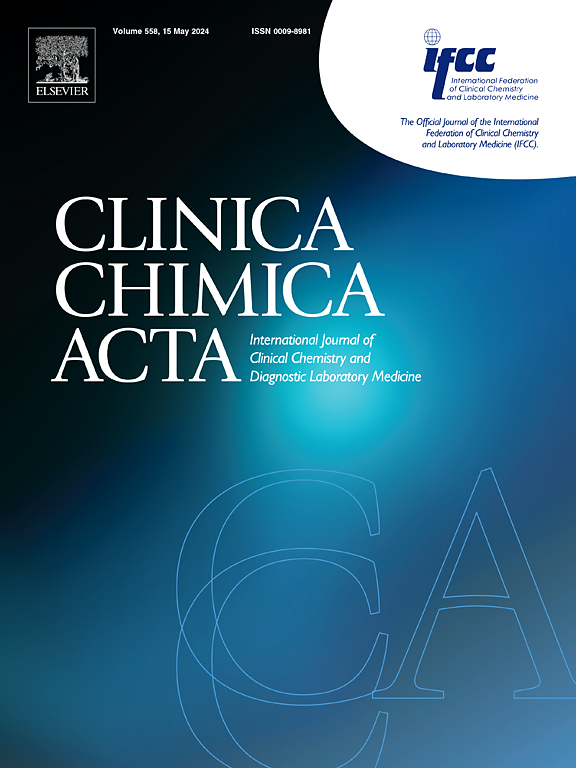基于治疗药物监测数据的曲唑酮实验室警戒水平影响因素分析
IF 2.9
3区 医学
Q2 MEDICAL LABORATORY TECHNOLOGY
引用次数: 0
摘要
目的以往的研究已经揭示了治疗药物监测对曲唑酮个体化给药的重要性。然而,关于曲唑酮血浆浓度超过实验室警戒水平的相关危险因素的研究缺乏。本研究旨在探讨影响曲唑酮血浆浓度剂量比(C/D)的因素。此外,它试图全面调查导致曲唑酮浓度超过1200 ng/mL的因素。方法在中国西安精神卫生中心进行一项单中心、回顾性、横断面研究,收集2020年至2023年曲唑酮治疗患者的数据。结果年龄、曲唑酮处方及合用氟伏沙明对曲唑酮的C/D比值有显著影响。此外,结果显示,21.67%每日接受25 - 200mg曲唑酮剂量的患者血浆浓度超过实验室警戒水平。采用入中心法进行logistic回归分析,确定患者年龄较大[1.04 (95 CI: 1.01-1.07)]、日剂量较高[1.04 (95 CI: 1.02-1.05)]、总蛋白水平较高[1.10 (95 CI: 1.02-1.19)]和同时使用氟伏沙明[7.99 (95 CI: 2.48-25.72)]是血浆浓度超过实验室警戒水平的危险因素。结论本研究为今后曲唑酮的个体化用药提供了重要的临床结果。关键词曲唑酮;治疗药物监测;实验室警戒水平;本文章由计算机程序翻译,如有差异,请以英文原文为准。
Analysis of factors affecting laboratory alert level of trazodone based on therapeutic drug monitoring data
Aims
Previous studies have revealed the importance of therapeutic drug monitoring for personalized trazodone dosing. However, studies on risk factors related to trazodone plasma concentrations that exceed laboratory alert levels are lacking. This study aimed to identify the factors influencing the trazodone plasma concentration-to-dose (C/D) ratio in the Chinese population. Additionally, it attempted to comprehensively investigate the factors contributing to trazodone concentrations exceeding 1200 ng/mL.
Methods
A single-center, retrospective, cross-sectional study was conducted at Xi’an Mental Health Center in China, where data on Trazodone-treated patients between 2020 and 2023 were collected.
Results
The C/D ratios of trazodone were significantly influenced by age, the formulations of trazodone, and the concomitant use of fluvoxamine. Additionally, the results revealed that 21.67 % of patients receiving daily trazodone doses of 25–200 mg demonstrated plasma concentrations exceeding laboratory alert levels. A logistic regression analysis using a enter method determined patient older age [1.04 (95 CI: 1.01–1.07)], higher daily dose [1.04 (95 CI: 1.02–1.05)], higher total protein level [1.10 (95 CI: 1.02–1.19)] and concomitant use of fluvoxamine [7.99 (95 CI: 2.48–25.72)] as risk factors for surpassing laboratory alert levels in plasma concentrations.
Conclusion
In conclusion, this study provides important and valuable clinical results for future personalized trazodone administration.
Keywords trazodone, therapeutic drug monitoring, laboratory alert level, related factors.
求助全文
通过发布文献求助,成功后即可免费获取论文全文。
去求助
来源期刊

Clinica Chimica Acta
医学-医学实验技术
CiteScore
10.10
自引率
2.00%
发文量
1268
审稿时长
23 days
期刊介绍:
The Official Journal of the International Federation of Clinical Chemistry and Laboratory Medicine (IFCC)
Clinica Chimica Acta is a high-quality journal which publishes original Research Communications in the field of clinical chemistry and laboratory medicine, defined as the diagnostic application of chemistry, biochemistry, immunochemistry, biochemical aspects of hematology, toxicology, and molecular biology to the study of human disease in body fluids and cells.
The objective of the journal is to publish novel information leading to a better understanding of biological mechanisms of human diseases, their prevention, diagnosis, and patient management. Reports of an applied clinical character are also welcome. Papers concerned with normal metabolic processes or with constituents of normal cells or body fluids, such as reports of experimental or clinical studies in animals, are only considered when they are clearly and directly relevant to human disease. Evaluation of commercial products have a low priority for publication, unless they are novel or represent a technological breakthrough. Studies dealing with effects of drugs and natural products and studies dealing with the redox status in various diseases are not within the journal''s scope. Development and evaluation of novel analytical methodologies where applicable to diagnostic clinical chemistry and laboratory medicine, including point-of-care testing, and topics on laboratory management and informatics will also be considered. Studies focused on emerging diagnostic technologies and (big) data analysis procedures including digitalization, mobile Health, and artificial Intelligence applied to Laboratory Medicine are also of interest.
 求助内容:
求助内容: 应助结果提醒方式:
应助结果提醒方式:


